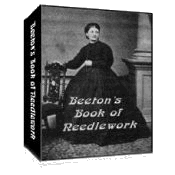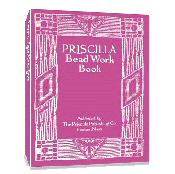[]Subscribe To This Site
Free Hand Embroidery Designs
Scotch Thistle Design
Free hand embroidery designs are available right here. The following Scotch Thistle design was a favorite of Victorian women.
Instructions for Making Scotch Thistle Design

Click on picture to see more detail.
This method of working the thistle has the advantages of representing it faithfully, and of being very easily and rapidly done. It looks exceedingly pretty worked or painted on white velvet, or light colored felt; made up into a wall banner, having plush sewed to the ends, and finished with pom-poms. Be careful to select a shade of plush and pom-poms that will harmonize with the material upon which you work. A brass rod and rings will complete the mountings. This design enlarged, would look pretty for sofa cushions, etc.
Make a pattern from the engraving, and stamp the design upon the velvet or felt, in the manner as described in Making a Perforated Pattern and Stamping a Pattern already described. This done, sew the material into an embroidery frame, and begin by working the stems with olive green embroidery silk with the stem stitch, giving the stitches the upward slant as shown in the illustration. Our engraving represents the work in different degrees of completion, and illustrates all the stitches used in working.
Now fill in the lower part (or bulb) of each blossom with a gray shade of Berlin wool, as shown in the engraving of the large blossom. Double the yarn and repeat the stitches till you give the bulb a natural rounded appearance.
This done, fill in three rows of French knots (just above the bulb, as seen in the large blossom), using the same shade of yarn as for the bulb. This furnishes a foundation for the mauve filloselle, which is next sewed down between the knots, in the following manner: a needle is threaded with strong thread; bring the needle up between the upper row of knots. Now place a double strand of mauve (a thistle pink) filloselle on the knots close to the thread; pass the needle back through the material, catching the filloselle about three-quarters of an inch from one end, draw the needle tightly. This has a tendency to make the filloselle stand out straight, and as you do not want this effect for the thistle, you at once see that something more is needed to make the filloselle lay flat to the velvet; hence we take another fastening stitch (as shown in the illustration) and catch both strands of the filloselle a little above the last stitch. The long end of the filloselle, seen in the engraving, is then clipped with a sharp pair of scissors, and this operation is repeated till three rows of filloselle are sewed down. A glance at the finished blossom in the engraving will give an idea of the effect aimed at.
The leaves are worked with a grayish green arrasene. Begin working at the bottom of the leaf, and slant the stitches upward, as shown in the leaf partly worked. The arrasene stitch is so plainly illustrated, that it will be readily learned by any one.
A large wool needle is threaded with arrasene; and brought up through the material at the center of the leaf; pass the needle down at the edge of the leaf see illustration), then bring it up again at the edge of the leaf; now take the needle down at the center of the leaf, and so on. By working in this manner, no arrasene is wasted on the under side. Work one- half of the leaf first and then the other, working from the center to the outside ill both cases. The lines seen in two of the leaves show the slant and about the distance one stitch should be from the other.
The leaves being worked and the upper parts of the blossoms being filled in with filloselle, now begin to cover the yarn foundation of each bulb (as seen in the large blossom) with the same shade of arrasene as for the leaves, taking the stitches in the same direction as those of the yarn foundation. Work the arrasene quite closely, so that none of the yarn foundation will show through. Bring the arrasene up so as to catch the lower part of the filloselle which forms the blossom.
Now thread a fine needle with olive green etching silk and carry long stitches back and forth, diagonally across the top of the arrasene bulb, as seen in the finished blossom; and with the same shade make short stitches here and there to represent the thorns on the leaf, as seen in the partly finished leaf. Now comb out the blossoms so give them a downy appearance, and trim off the ends of the blossom, and your work is ready to be made up into any article that fancy might suggest.
Follow the links to find other wonderful Victorian free hand embroidery designs that you are sure to love:
Dogwood Design
Return to top of Free Hand Embroidery Designs page.
Return to Special Designs page.
Return to Home page.



 433 pages!
433 pages!

